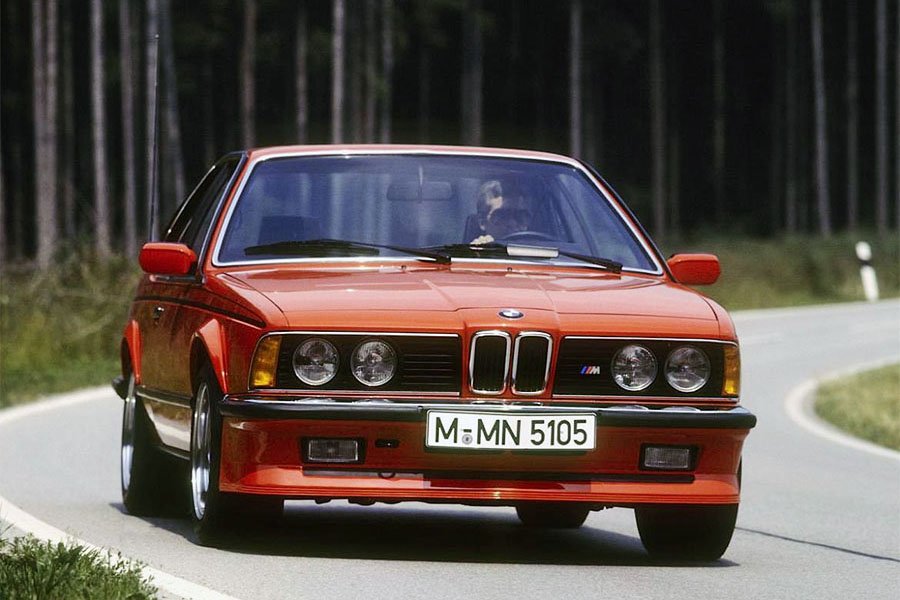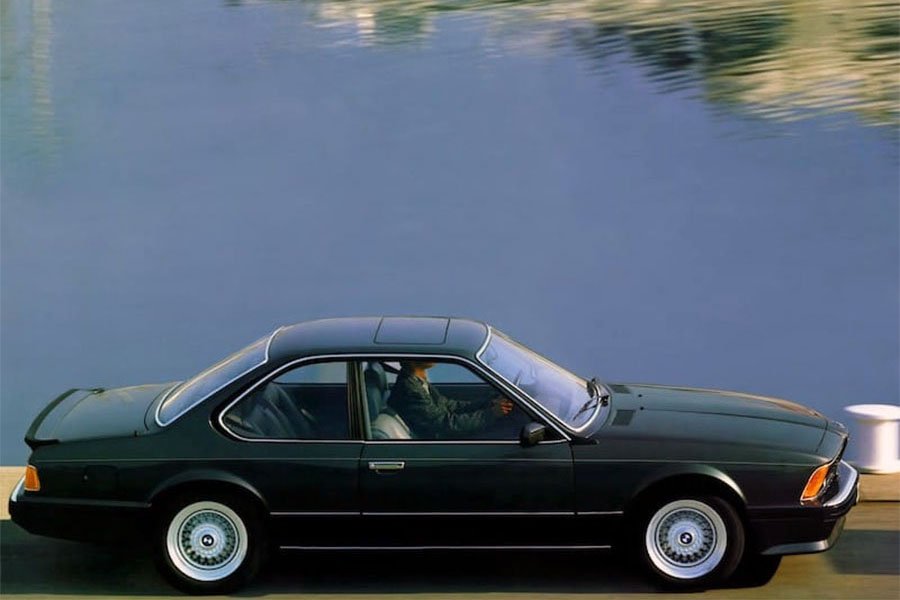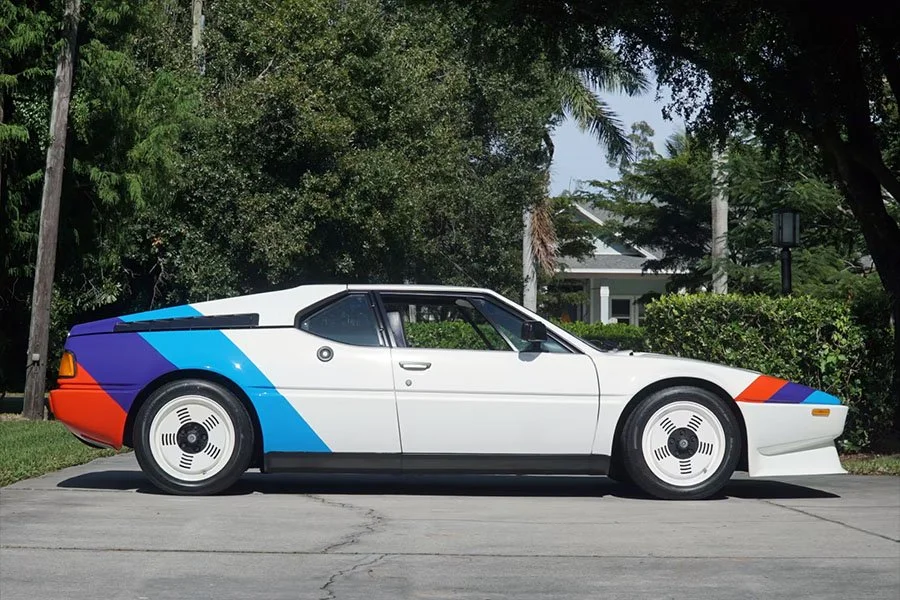Guide: BMW E24 M635 CSi - a Historical & Technical Appraisal
/BACKGROUND
When it was time to create a replacement for the elegant Wilhelm Hofmeister-designed E9 Coupe, BMW turned to their recently appointed head of stying, Paul Bracq.
Bracq joined BMW in 1970. His innovative E25 Turbo concept (unveiled at the Paris Motor Show in October 1972) was joined by handsome designs for the 3, 5, 6 and 7-series. Together it was this new range of machines that transformed BMW into a major player in the premium car sector.
Bracq’s shark-nose E24 6-series was a four-seat, rear-wheel drive Coupe initially based on the mid-range E12 5-series platform.
Production began at Karmann’s Osnabruck factory in October 1975, but much secrecy surrounded the new model and it was not publicly revealed until March 1976 at the Geneva Motor Show.
Two variants were initially available, the 182bhp 630 CS and the 197bhp 633 CSi, both of which used BMW’s single overhead camshaft M30 straight six.
In August 1977, bodyshell production was transferred from Karmann to BMW’s Dingolfing plant.
A 215bhp 635 CSi with an M90 engine joined the range in 1978. When the M30-powered 628 CSi was launched in 1979, the original 630 CS and 633 CSi were discontinued.
For the 1982 model year, the 6-series was switched from the E12 to the recently introduced E28 5-series platform. As a result, there were subtle alterations to all aspects of the car, but cosmetically relatively little was changed.
During the 6-series’ life thus far, BMW had resisted the temptation to have their Motorsport-department produce a hot driver-focused variant.
However, at the Frankfurt Motor Show in September 1983, just such a machine finally broke cover.
The new M635 CSi followed the E9 3.0 CSL, the E20 2002 Turbo, the E26 M1 and various iterations of the E12 5-series that had come in for the BMW Motorsport treatment. It was powered by an evolution of the M1’s advanced dual overhead camshaft 24 valve engine and received the kind of enhanced chassis dynamics that BMW’s M-division had become renowned for.
Like all E24 6-series, the M635 CSi was built on the normal Dingolfing assembly line as the BMW Motorsport facility did not have the capacity to fulfil demand. Production began in February 1984.
CHASSIS
Each M635 CSi started life as a standard E24 pressed steel bodyshell. A 2625mm wheelbase ensured there was plenty of internal space to seat four occupants.
As usual, the independent suspension layout comprised MacPherson struts up front and semi-trailing arms at the rear. Anti-roll bars were fitted at either end.
To this, BMW Motorsport added shorter and stiffer springs that dropped the ride height by 10mm. Special gas-filled Bilstein shocks were installed and the front anti-roll bar was beefed up to 25mm instead of 19mm. The original 16mm diameter rear anti-roll bar was retained.
To improve traction and the E24’s 57 / 43 front-to-rear weight distribution, the M635 CSi’s larger 90 Ah battery was mounted in the trunk as opposed to up against the front bulkhead.
The normal 282mm diameter ventilated front disc brakes were switched to bigger 300mm items with new four-piston calipers. Solid 284mm discs were retained at the rear, but they did now come with bigger caliper pistons.
BMW Motorsport also re-tuned the Anti-lock Brake System and installed a modified brake servo.
As standard, the M635 CSi was equipped with the same forged alloy cross-spoke wheels as the 635 CSi. These metric-sized wheels were designed for Michelin’s TRX tyres and measured 390mm x 165mm (about 15.4 x 6.5-inches).
However, many cars were expected to be equipped with optional three-piece rims that measured 415mm x 195mm (about 16.3 x 7.7-inches). In anticipation of this, the M635 CSi was given increased steering castor to preserve steering response.
Power steering that provided variable assistance according to engine speed was standard.
A regular 70-litre fuel tank was installed in the trunk floor alongside the spare wheel well.
ENGINE / TRANSMISSION
Whereas the rest of the E24 range used single overhead camshaft straight six engines with two valves per cylinder, the M635 CSi was equipped with a twin cam 24 valve engine derived from the fabled M1.
The Type M88/3 engine fitted to the M635 CSi differed from the M1 power unit on account of its wet-sump lubrication system, new pistons and connecting rods and updated second generation Bosch Motronic digital engine management which controlled the spark timing and the electronic injectors with far greater precision. This in turn allowed the compression ration to be hiked from 9.0:1 to 10.5:1.
Like the M1, the M635 CSi featured a crossflow cylinder head, a specially tuned intake system with six individual throttle bodies and an artistically crafted bundle of six intertwined exhaust manifolds.
It was immediately identifiable compared to regular 6-series engines thanks to an M Power script and BMW badge on the valve cover. Like all BMW 3.5-litre engines of this era, it featured a cast-iron block while the head was formed in aluminium alloy. Displacement was 3453cc thanks to a bore and stroke of 93.4mm and 84mm respectively.
Peak output was 282bhp at 6500rpm and 251lb-ft at 4500rpm.
In comparison, the M1 had pumped out 277bhp at 6500rpm and 239lb-ft at 5000rpm.
The regular 635 CSi produced 215bhp at 5200rpm and 229lb-ft at 4000rpm.
Transmission was through a special close-ratio Getrag 280/5 five-speed manual gearbox, a single-plate hydraulic clutch and a limited-slip differential with 25% locking factor.
BODYWORK
Paul Bracq’s original design for the E24 6-series was so accomplished that relatively few changes were made during the 15 years the model stayed in production. It was most famously characterised by its shark-nose front end, slender profile and slim pillared five window cabin.
In typical BMW Motorsport fashion, the M635 CSi did not look substantially different from the standard variants.
To reduce lift, a deep new spoiler was installed at the front. This featured an arrow-like profile and was given three distinct ribs at its base.
All four wheelarch lips were subtly flared.
The only other additions were M badges on front grille and trunk lid and body coloured instead of chrome exterior mirror housings.
At the rear of the car, the black rubber lip spoiler found on the 635 CSi was retained.
At 0.39, the M635 CSi’s drag coefficient was slighly superior to the standard 635 CSi (0.4)
INTERIOR
As per the exterior, the interior was little changed.
Each M635 CSi came with a special 380mm diameter three-spoke leather-rimmed M-Technic steering wheel and the manually adjustable sports seats that were an option on the regular 6-series.
There was also a special instrument cluster with a 280kph / 170mph speedo and a Motorsport-branded 8000rpm rev counter. Small read outs for water temperature and fuel were stacked one above the other in the centre of the binnacle with an array of warning lights in between and at the base. Unlike other E24s, the M635 CSi did not come with a fuel economy meter.
Highland velour cloth upholstery was fitted as standard along with electric windows, electric mirrors, BMW’s second generation on-board computer and a leather gear knob.
Ergonomically the E24 was superbly designed. Visibility was also excellent and there was plenty of space including in the back of the car where individually contoured rear seats were fitted.
OPTIONS
Optional extras included metallic paint, an electric sunroof, electric front seats, heated front seats, normal leather or Buffalo hide upholstery, air-conditioning, an alarm, cruise control, a rear sun blind, rear head rests, green-tinted heat-insulating glass, headlight wash / wipe and a choice of audio systems.
Buyers could also specify the aforementioned split rim wheels and request the Motorsport exterior badges be deleted.
Some markets bundled a variety of options in as standard such as in the UK where leather, tinted glass and an electric sunroof were fitted to all cars.
WEIGHT / PERFORMANCE
Compared to the 635 CSi, the new Motorsport variant was 78kg heavier (1505kg).
However, it was also substantially faster.
Top speed went from 140mph to 158mph.
The 0-62mph time dropped from 6.8 seconds to just 6.2 seconds.
PRODUCTION CHANGES
Left-hand drive production began in February 1984.
Right-hand drive production began in September 1984.
In September 1985, BMW fitted a revised rear spoiler with a body coloured main element and black rubber lip. A new Shadowline option was also added that saw the entire body de-chromed except for the front kidney grilles, headlights bezels and radio antenna (which could also be given the Shadowline treatment upon request).
In September 1986, BMW replaced the optional three-piece wheels (which were found to have durability issues) with a single-piece unit. They also introduced a more robust double valve spring design for the engine.
In November 1986, a cat-equipped S38 engine was added to the options list for European markets. In addition to a catalytic converter, the S38 engine came with a simplified exhaust manifold, a duplex timing chain, 248° instead of 264° camshafts, a lower 9.8:1 compression ratio and a BMW M Power valve cover script but no BMW roundel. Peak output was 256bhp at 6500rpm and 243lb-ft at 4500rpm. These cars also ran a different final drive ratio (3.91:1 instead of 3.73:1).
The S38 engine was developed so that BMW could offer the M635 CSi in North America and Japan (where it was marketed as the M6).
In June 1987, BMW gave the 6-series a mild facelift. Externally, all cars now came with bigger body coloured bumpers, a re-shaped front apron (shared with the 635 CSi) and ellipsoid instead of halogen front lights.
Inside, the leather shift knob from the E32 7-series was fitted along with a new type of cloth upholstery to replace the Highland fabric.
BMW introduced a Highline Nappa leather option where almost all the interior surfaces were covered in hide to include the seats, door panels, centre console, dash, glovebox cover, sun visors and door pillars. Cars bound for the USA, the UK and Japan came with the Highline pack fitted as standard.
Another new option was a rear air-conditioning unit with a central storage box between the seats.
In May 1988, the power steering was switched from an engine-speed sensitive system to road-speed sensitive.
In September 1988, the electric front seat controls were moved from the centre console to the base of the seat.
NORTH AMERICAN VERSION
The cat-equipped S38 engine was used to power a North American version of the M635 CSi which, for marketing reasons, was dubbed the M6.
Production began as soon as the S38 motor was ready in November 1986.
The North American M6 kept the special gas-filled Bilstein dampers and thicker front anti-roll bar of the regular M635 CSi, but used standard springs from the 635 CSi which meant it sat 10mm higher than Euro market iterations.
To meet safety standards, bulkier 5mph impact-absorbing bumpers were installed.
Special M6 badges were fitted instead of the simple M badges used in other markets.
Standard equipment included leather upholstery, electric seats with driver-side memory function, cruise control, air-conditioning, rear air-conditioning with a central storage unit between the seats, a rear sun blind and eight speaker stereo.
Heated seats were also standard in Canada.
Later facelift versions of the M6 bound for North America had additional cooling slots in the front apron.
When the facelift variant arrived, North American cars adopted the same bumpers used throughout the rest of the world. The Highline trim package was standard and cars bound for the USA now came with a driver airbag (but not those destined for Canada).
JAPANESE VERSION
Aside from black exhaust tips and a higher level of standard equipment, the Japanese market version (also marketed as the M6) was broadly the same as the cat-equipped Euro market cars.
Cars bound for Japan came with an electric sunroof, electric front seats, air-conditioning, rear air-conditioning with a central storage unit between the seats and a rear sun blind.
Later on, heated front seats with memory function for the driver also joined the list of standard equipment.
Interior upholstery was limited to either cloth or Buffalo leather.
M635 CSI MOTORSPORT EDITION
To mark the end of M635 CSi production, BMW Great Britain ordered a batch of special Motorsport Edition cars.
They came with all the usual equipment that was standard for the UK market plus unique M-striped seat inserts and Shadowline trim.
The Motorsport Edition M635 CSi was officially limited to three colour schemes:
- Misano Red with Black Nappa Highline leather upholstery (10 built)
- Nogaro Silver with Black Nappa Highline leather upholstery (5 built)
- Macao Blue with Lotus White Nappa Highline leather upholstery (5 built)
One special order car was also completed taking the total run to 21 vehicles.
Production ran from October 1988 to January 1989, after which assembly of the standard M635 CSi briefly resumed.
The Motorsport Edition (option code 129) was also offered on the regular 635 CSi platform (188 of which were built).
END OF PRODUCTION
BMW discontinued the M635 CSi in February 1989 when the last right-hand drives examples rolled out of the factory. Left-hand drive production had ended in December 1988.
In total, 5855 were built.
This figure was split as follows:
LHD Euro market with no cat (02/84 to 12/88) 3283 units (83 of which were facelift variants)
RHD UK market with no cat (09/84 to 02/89) 524 units (102 of which were facelift variants)
LHD Euro market with cat (11/86 to 12/88) 117 units (80 of which were facelift variants)
LHD North American market with cat (11/86 to 09/88) 1767 units (1034 of which were facelift variants)
LHD Japanese market with cat (11/86 to 03/88) 164 units (116 of which were facelift variants)
The E24 6-series was ultimately replaced by the much more expensive E31 8-series.
Unfortunately, a BMW Motorsport version of the 8-series never made it into production.
Text copyright: Supercar Nostalgia
Photo copyright: BMW - https://www.bmw.com







































